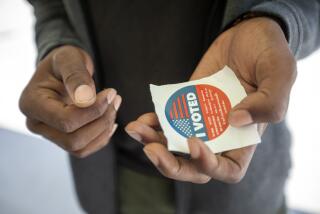Electing to Vote Early
- Share via
Americans do love their e-mails and shopping online, their cellphones and convenience stores, their overnight deliveries and 24-hour 800 numbers. So it should not be surprising that they also love the convenient opportunity to vote when they want, often weeks in advance of official election dates. What’s surprising is how rapidly the phenomenon is evolving in most states.
Depending on your viewpoint, early voting either threatens or promises to turn election days into mere deadlines for a lengthened balloting process with undetermined political and social consequences.
For most of U.S. history, the sacred autumnal votes for presidents and Congress have been a near-simultaneous civic ritual across the land. Though barely half of people eligible to vote bother to do so even in most presidential years, election day has provided a powerful image and sense of shared experience for millions. No longer.
In some states, more than half the votes are now cast, and even quietly counted, before election day. Oregon has no polling places, only mail ballots. In some of the 32 states offering a form of advance voting, ballots can be cast up to six weeks early. In states like Ohio, the absence of advance voting created long lines late into election night.
In part, the advent of more-convenient voting procedures is driven by efforts to boost voter participation. Easier voting equals more voting, according to this philosophy. Absentee voting once required a written excuse. Today, thousands use it as a form of early voting. But they’re a fraction of the Americans who simply vote early, often on a touch screen, under a variety of new and amended state laws.
In Nevada, which copied and expanded Texas’ early voting advances, by election day last month nearly 300,000 of the state’s 800,000 eventual voters had cast ballots at schools, groceries and convenience stores, aided by election workers with instant access to countywide records. Votes were cast across town, during lunch, far from home precincts. More than half of Texas ballots were cast before election day, as were nearly two of three in Washington state.
Though evidence is scant, supporters say advance voting increases turnout. More likely, it stems declines. What’s indisputable is early voting’s effects on politics. It affects campaign schedules and plans. It opens a wider window on get-out-the-vote efforts, providing weeks, not a few hours, to cajole, remind and transport supporters to vote.
Early voting changes the whole closing campaign calculus. Why announce new programs in October if half the votes have already been cast? It also forces campaigns to schedule events and ads in advance voting areas sooner, potentially adding to costs.
Early voting does raise questions. If an October voter dies before election day, is that a valid vote? So far, yes. Leaked partial exit polls produced misleading expectations last election day. Will early voters’ exit results be similarly leaked for weeks, producing an influential if illicit sense of momentum? Much about the early voting tide remains to be studied and adjusted.
But today, just under 47 months from the next presidential election, it’s certain that Americans will keep voting for convenience.
More to Read
Get the L.A. Times Politics newsletter
Deeply reported insights into legislation, politics and policy from Sacramento, Washington and beyond. In your inbox three times per week.
You may occasionally receive promotional content from the Los Angeles Times.










